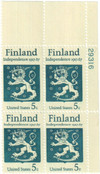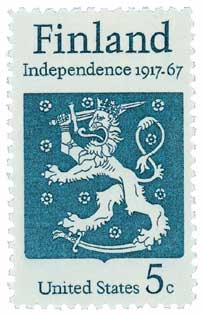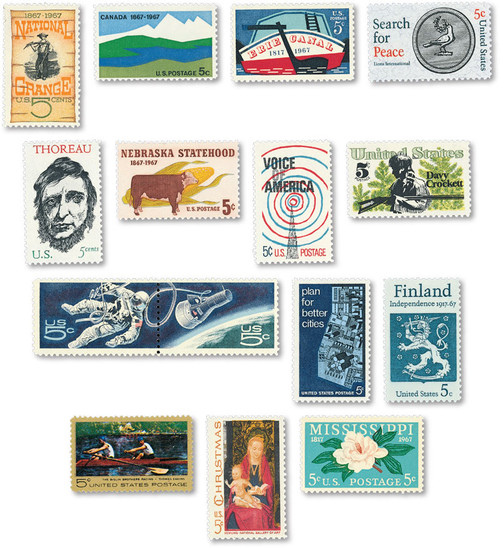
# 1334 PB - 1967 5c Finnish Independence
Issue Date: October 6, 1967
City: Finland, MN
Quantity: 110,670,000
Printed By: Bureau of Engraving and Printing
Printing Method: Giori Press
Perforations: 11
Color: Bright greenish blue, green and red brown
Finnish Independence
The Kingdom of Sweden had ruled Finland since the 13th century. In 1742, during the Russian occupation in the Russo-Swedish War, the first recorded mention of Finnish independence was made. At that time, Empress Elizabeth of Russia spoke to the people of Finland in the Finnish language telling them to create a Finland that was independent from Sweden and Russia. A duke was elected – but no further action was taken.
Then in 1808, the Finnish War broke out between Russia and Sweden. In the end, Russia took control of Finland and established it as the Grand Duchy of Finland in 1809. Under Russian rule, Finland developed governing bodies and was “elevated as a nation among nations.” Finland also began to develop a national identity – encouraging the people to use the Finnish language instead of Swedish and adopting their own currency.
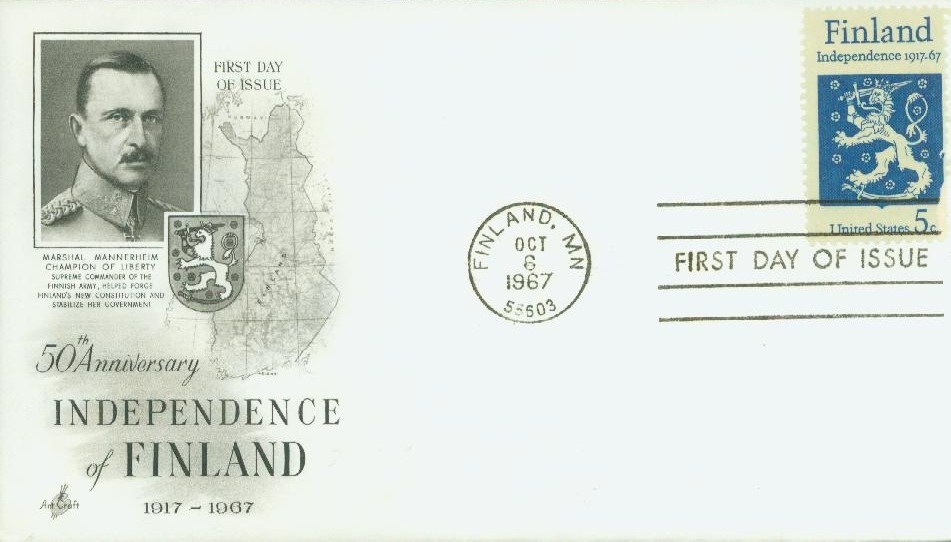
However, by the early 1900s, tensions began to rise between Finland and Russia. Russia ordered changes to the Finnish army, demanding that they only fight to defend Finland, but that they might also be called on to fight for Russia on any front. A resistance movement formed to combat Russian rule. During the Russo-Japanese War, they unsuccessfully attempted to smuggle a large number of guns by steamship. Later that year, the Finnish general strike briefly stopped the Russification of Finland.
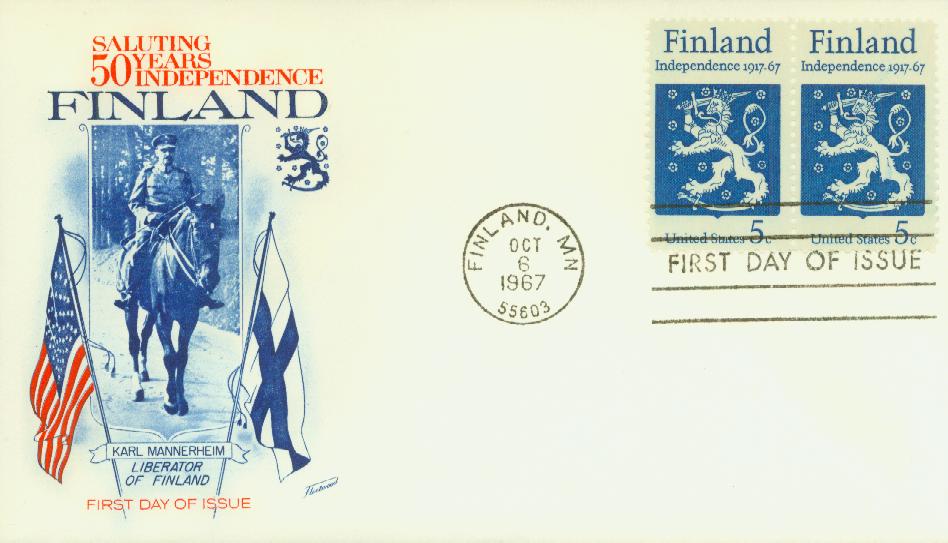
Finland then created a liberal democracy with the right to vote and be elected. They also established a Parliament, but their power was limited by Russia. Russia began pushing for greater control over Finland, but the outbreak of World War I stopped much of these plans. Two thousand Finnish volunteers then traveled to Germany to train as elite light infantry for the resistance movement. They then went to Russia to fight against the Russian Empire.

In 1917, Tsar Nicholas II abdicated and Russia’s control over Finland began to dissolve. Finnish authorities then entered into negotiations with Russia’s Provisional Government. On December 4, 1917, the Senate of Finland released a declaration of independence, and parliament adopted the declaration two days later. A portion of the preamble states, “…Finland’s people step forward as a free nation among the other nations in the world…”
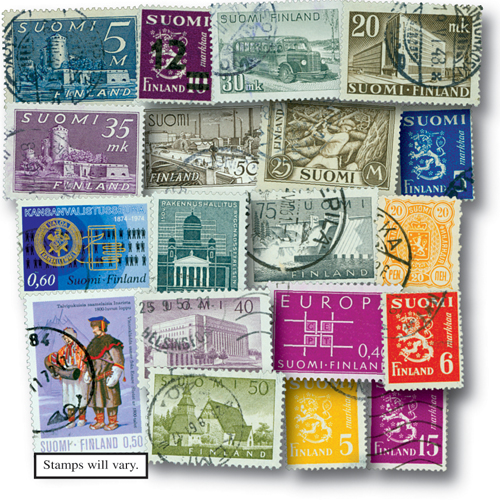
The transition to an independent nation was not easy. A civil war soon broke out between conservative and socialist forces. After a brief monarchy with ties to Germany, Finland finally held free elections in March 1919. The country became a republic and was recognized by the US and Britain.
Click here to read the Finnish Declaration of Independence.
Issue Date: October 6, 1967
City: Finland, MN
Quantity: 110,670,000
Printed By: Bureau of Engraving and Printing
Printing Method: Giori Press
Perforations: 11
Color: Bright greenish blue, green and red brown
Finnish Independence
The Kingdom of Sweden had ruled Finland since the 13th century. In 1742, during the Russian occupation in the Russo-Swedish War, the first recorded mention of Finnish independence was made. At that time, Empress Elizabeth of Russia spoke to the people of Finland in the Finnish language telling them to create a Finland that was independent from Sweden and Russia. A duke was elected – but no further action was taken.
Then in 1808, the Finnish War broke out between Russia and Sweden. In the end, Russia took control of Finland and established it as the Grand Duchy of Finland in 1809. Under Russian rule, Finland developed governing bodies and was “elevated as a nation among nations.” Finland also began to develop a national identity – encouraging the people to use the Finnish language instead of Swedish and adopting their own currency.

However, by the early 1900s, tensions began to rise between Finland and Russia. Russia ordered changes to the Finnish army, demanding that they only fight to defend Finland, but that they might also be called on to fight for Russia on any front. A resistance movement formed to combat Russian rule. During the Russo-Japanese War, they unsuccessfully attempted to smuggle a large number of guns by steamship. Later that year, the Finnish general strike briefly stopped the Russification of Finland.

Finland then created a liberal democracy with the right to vote and be elected. They also established a Parliament, but their power was limited by Russia. Russia began pushing for greater control over Finland, but the outbreak of World War I stopped much of these plans. Two thousand Finnish volunteers then traveled to Germany to train as elite light infantry for the resistance movement. They then went to Russia to fight against the Russian Empire.

In 1917, Tsar Nicholas II abdicated and Russia’s control over Finland began to dissolve. Finnish authorities then entered into negotiations with Russia’s Provisional Government. On December 4, 1917, the Senate of Finland released a declaration of independence, and parliament adopted the declaration two days later. A portion of the preamble states, “…Finland’s people step forward as a free nation among the other nations in the world…”

The transition to an independent nation was not easy. A civil war soon broke out between conservative and socialist forces. After a brief monarchy with ties to Germany, Finland finally held free elections in March 1919. The country became a republic and was recognized by the US and Britain.
Click here to read the Finnish Declaration of Independence.



